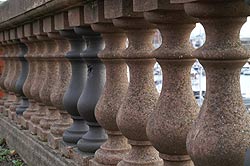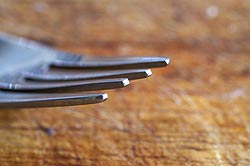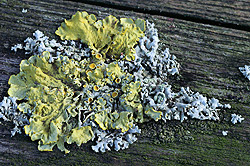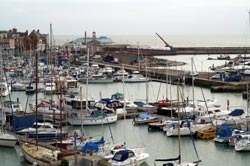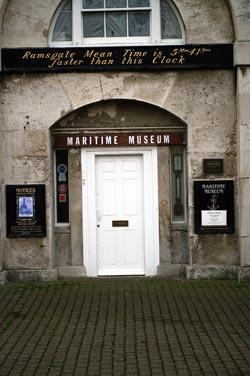Konica Minolta AF Macro 50mm f/2.8 (D)
Despite coming to the digital SLR market later than the competition, Konica-Minolta, or more accurately Minolta, already had many years experience in the interchangeable lens market and a good offering of lenses for their system. Here we take a look at the 50mm f/2.8 Macro (D) offering from that stable.
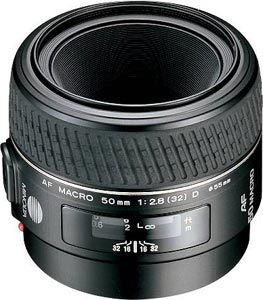 Specifications
Specifications
- Focal length 50mm
- Filter thread 55mm
- Max aperture f/2.8
- Min aperture f/32
- Elements/groups
- Closest focus 20cm
- Ratio 1:1
- Dimensions 71.5x60mm
- Weight 0.295kg
- Mount Minolta A type bayonet
- Tripod Bush No
- Price (SRP) 499.99
Build and handling
The build quality of this lens on first picking it up appears good and further inspection re-enforces the impression. It is solid with no obvious weak links. A short way from the mount (15mm) the barrel expands by some eight millimetres before you get to the distance window marked in both metres and feet and engraved with a useable depth-of-field scale. To the left of this is a button for locking the focus that only works whilst depressed and in all honesty seemed a little superfluous. Close by this is a limiter switch, operated by a quarter turn, which is a useful addition to any Macro lens. It operates each side of the 12/0.3m mark, needing to be turned off to get through that point to the other side. It is a solid, well-made switch that gave no concerns as to its longevity. The manual focus ring, which is covered in a well-ribbed rubberised finish, occupies the remainder of the lens.
Focussing causes the front element of the lens to extend some 48mm although the front element does not rotate, making the use of 55mm filters a simple task. The manual operation of the ring is nicely torqued and smooth in use. Once the autofocus is engaged however, the motor is noisy and not particularly fast, even for macro lenses, which have never been regarded as fast focussing anyway. The closest focus distance of 20cm is from the film/sensor plane and at 1:1 the front end of the lens is only some 30mm from the subject. There is no provision for fitting a lens hood on the lens unless a screw fitting one is employed in the filter thread.
Optical Quality
This lens is surprisingly consistent throughout the aperture range as far as resolving power is concerned. It is also very consistent from centre to edge, although it should be remember that it was tested on a sensor with a 1.5x crop factor. Distortion is very well controlled, with a figure of 0.0525% barrel recorded which is negligible and not discernable with the naked eye.
Chromatic aberrations at the centre of the image were minimal but as you travel towards the edges they did start to rear their ugly heads and in the corners were quite noticeable. This is the one area that the lens let itself down and is a sign that the lens was originally designed for full frame film capture. More recent designs have come a long way in overcoming this problem. Software packages will, however, correct the problem although this does involve extra work in the post processing.
|
|
|
Click on each comparision photo below to view full size versions
Below is our lens test data. To find out how to use these graphs look at this article: How we test lenses
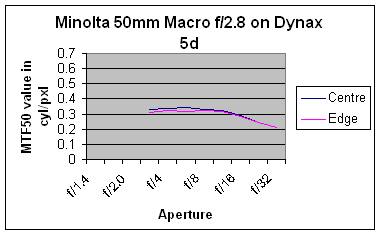
Verdict
Minolta, or Konica Minolta as they are now, have a long standing reputation for the quality of their lenses and for the most part this example does not disappoint. Build quality is good and the lens handled well with the exception of the autofocus. Optical quality, especially the resolving power is good and consistent, although CA does creep in towards the edges. Overall a good buy if you can get it at the right price.
In summary, the positive points of the K-M AF f/2.8 50mm Macro (D) are:
![]() Good build quality
Good build quality
![]() Consistent across all apertures
Consistent across all apertures
![]() Smooth manual focus
Smooth manual focus
The negative points are:
![]() AF slow and noisy (even for a Macro)
AF slow and noisy (even for a Macro)
![]() No provision for hood
No provision for hood
![]() Price
Price
Check the latest price for the Konica Minolta AF f/2.8 50mm Macro (D) here
Test by Ian Andrews www.wildaboutkent.co.uk
Add your message
Please login here or if you've not registered, you can register here. Registering is safe, quick and free.
photodo Stats
428 MTF tests
74 in-depth photodo reviews
100+ users join each day
Help the lens community by reviewing or rating a lens today via our lens search
Latest Lens Reviews
- Chinon 28mm f/2.8 Vintage Lens Review
- Canon EF 70-200mm f/4L IS II USM Lens Review
- Samyang AF 85mm f/1.4 EF Review
- Sigma 70mm f/2.8 DG Macro Art Review
- Samyang AF 24mm f/2.8 FE Review
- Meike 50mm f/1.7 Review
- Tamron 70-210mm f/4 Di VC USD Review
- Lensbaby Burnside 35mm f/2.8 Review
- Asahi Super Takumar 50mm f/1.4 Review
- Asahi Super-Multi-Coated Takumar 135mm f/3.5 Review
